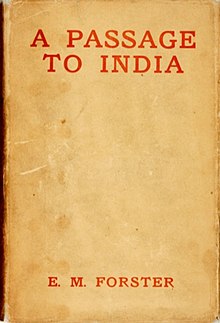
Back আ প্যাসেজ টু ইন্ডিয়া Bengali/Bangla Auf der Suche nach Indien German A Passage to India Esperanto Pasaje a la India (novela) Spanish گذری به هند Persian Route des Indes (roman) French Passaggio in India (romanzo) Italian ಭಾರತ ಮಾರ್ಗ Kannada 인도로 가는 길 Korean എ പാസേജ് ടു ഇന്ത്യ Malayalam
 First edition (UK) | |
| Author | E. M. Forster |
|---|---|
| Language | English |
| Genre | novel |
| Set in | British India, c. 1910s |
| Publisher | Edward Arnold, (UK) Harcourt Brace (US) |
Publication date | 4 June 1924[1] |
| Publication place | United Kingdom |
| Media type | Print (hardback & paperback) |
| OCLC | 59352597 |
| 823.912 | |
| LC Class | PR6011.O58 P3 |
| Text | A Passage to India at Wikisource |
A Passage to India is a 1924 novel by English author E. M. Forster set against the backdrop of the British Raj and the Indian independence movement in the 1920s. It was selected as one of the 100 great works of 20th-century English literature by the Modern Library[2] and won the 1924 James Tait Black Memorial Prize for fiction.[3] Time magazine included the novel in its "All Time 100 Novels" list.[4] The novel is based on Forster's experiences in India, deriving the title from Walt Whitman's 1870 poem "Passage to India" in Leaves of Grass.[5][6]
The story revolves around four characters: Dr. Aziz, his British friend Mr. Cyril Fielding, Mrs. Moore, and Miss Adela Quested. During a trip to the fictitious Marabar Caves (modelled on the Barabar Caves of Bihar),[7] Adela thinks she finds herself alone with Dr. Aziz in one of the caves (when in fact he is in an entirely different cave; whether the attacker is real or a reaction to the cave is ambiguous), and subsequently panics and flees; it is assumed that Dr. Aziz has attempted to assault her. Aziz's trial, and its run-up and aftermath, bring to a boil the common racial tensions and prejudices between Indians and the British during the colonial era.
- ^ "The 100 best novels: No 47 – A Passage to India by EM Forster (1924)". The Guardian. 18 August 2014. Retrieved 16 January 2015.
- ^ Lewis, Paul (20 July 1998). "'Ulysses' at Top As Panel Picks 100 Best Novels". The New York Times. Archived from the original on 8 January 2015. Retrieved 8 January 2015.
- ^ "Fiction winners Award winners". The University of Edinburgh. 22 August 2014. Archived from the original on 31 October 2013. Retrieved 8 January 2015.
- ^ "All Time 100 Novels". Time. 16 October 2005. Archived from the original on 13 March 2010. Retrieved 23 April 2010.
- ^ Sarker, Sunil Kumar (1 January 2007). A Companion to E.M. Forster. Atlantic Publishers & Dist. p. 702. ISBN 978-81-269-0750-2. Retrieved 8 January 2015.
- ^ Kummings, Donald D. (19 October 2009). A Companion to Walt Whitman. John Wiley & Sons. p. 21. ISBN 978-1-4051-9551-5. Retrieved 8 January 2015.
- ^ Sarker, Sunil Kumar (1 January 2007). A Companion to E.M. Forster. Atlantic Publishers & Dist. p. 708. ISBN 978-81-269-0750-2. Retrieved 8 January 2015.